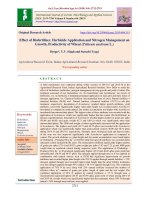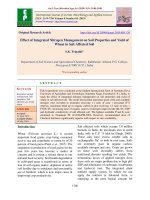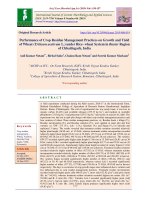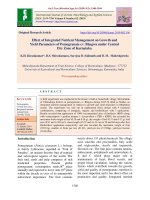Effect of soil test crop response basis integrated nitrogen management on growth and yield of wheat (Triticum aestivum L.)
Bạn đang xem bản rút gọn của tài liệu. Xem và tải ngay bản đầy đủ của tài liệu tại đây (194.38 KB, 7 trang )
Int.J.Curr.Microbiol.App.Sci (2018) 7(6): 3708-3714
International Journal of Current Microbiology and Applied Sciences
ISSN: 2319-7706 Volume 7 Number 06 (2018)
Journal homepage:
Original Research Article
/>
Effect of Soil Test Crop Response Basis Integrated Nitrogen Management
on Growth and Yield of Wheat (Triticum aestivum L.)
Manish Kakraliya1 and Rajesh Singh2*
Department of Agronomy, Sam Higginbottom University of Agriculture, Technology and
Sciences, Allahabad, India
*Corresponding author
ABSTRACT
Keywords
Wheat, Integrated
nitrogen
management, Level
of nitrogen, Growth
and Yield
Article Info
Accepted:
30 April 2018
Available Online:
10 June 2018
A field experiment was conducted during the rabi season of 2017 in wheat crop (var.
HUW-234) at Crop Research Farm, Department of Agronomy, Naini Agricultural
Institute, SHUATS, Allahabad (U.P.). The experiment was laid out in a Randomized Block
Design with 12 treatment combinations, consisting of three nitrogen levels (100,125 and
150 kg N/ha) on soil test basis (STB) compared to farmer practice (FP) and nitrogen
management viz. 100% N through urea, 75% N through urea + 25% N through
vermicompost with seed inoculation by Azotobacter. The experimental result reveals this
saving of nitrogen by 16.5 to 31.7 kg/ha without any significant effect on growth and yield
of wheat was noticed. The growth parameters viz. plant height, no. of tillers/running row
meter, Crop-growth rate (CGR), and Yield attributes viz. No. of effective tillers/m 2,
grains/spike and grain yield (4.57 t/ha) were significantly higher with 150 kg N/ha
(Farmer Practice) when applied 100 % N through urea, where as plant dry weight, leaf area
index (LAI) and straw yield (7.63 t/ha) were significantly higher with 150 kg N/ha (Farmer
Practice) when applied 75% N through urea + 25% N through vermicompost +
Azotobacter (Seed inoculation).
Introduction
Wheat (Triticum aestivum L.) is the most
important staple food of about 36% of the
world population and improvement in its
productivity has played a key role in making
the country self-sufficient in food grains.
Worldwide this crop provides nearly 55% of
the carbohydrates and 20% of the food
calories. USDA, 2017 report shows that it is
grown in all the continents of the world
covering an area of 225.07 million hectares
with production of 736.98 million tonnes. In
India, total area under wheat is 31.72 million
hectares with the production and productivity
of 96.0 million tonnes and 3.13 tonnes
hectares, respectively (Tiwari et al., 2017).
Nitrogen is subjected to different kinds of
losses like denitrification, volatilization and
leaching which causes environmental threats.
Nitrous oxide has contributed 310 times to the
global warming potential of carbon dioxide,
and its emissions are affected by poor nitrogen
3708
Int.J.Curr.Microbiol.App.Sci (2018) 7(6): 3708-3714
management in intensive crop production
which is major source for it (Jat et al., 2014).
Therefore, the continuous availability of N to
wheat during various phases of its growth and
development is important factors which
influence the grain quality and yield of wheat.
The basic concept underlying the principles of
integrated nutrient management (INM) is the
maintenance and possibly improvement of soil
fertility for sustaining crop productivity on
long term basis. This may be achieved through
combined use of all possible sources of
nutrients and their scientific management for
optimum growth, yield and quality of different
crops and cropping systems (Patel et al.,
2017). Nambiar and Abrol (1989) and Gupta
et al., (2000) also reported that under
continuous and high intensive farming, the
nutrient supplying power of most of the soils
has been found to be decline particularly when
rice based cropping systems are followed. Due
to decline in soil fertility, farmers have to use
more and more fertilizer year after year to
obtain optimum yield (Hobbs et al., 1990).
The excessive and imbalance use of inorganic
fertilizer was reported to be the major
constraint of declining productivity of rice–
wheat cropping system (Hobbs, 1994). When
these crops are grown under good
management conditions, they remove large
quantities of nutrients.
However, insufficient N availability to wheat
plants results in low yields and significantly
reduced profits compared to a properly
fertilized crop. Efficient nutrient-management
programmes supply plant nutrients in adequate
quantities to sustain maximum crop
productivity
and
profitability
while
minimizing environmental impacts of nutrient
use (Jat et al., 2013). Ensuring optimum
nutrient availability through effective nutrientmanagement practices requires knowledge of
the interactions between the soil, plant and
environment. In this experiment use of some
tools for in season nitrogen management like
Site-specific nutrient management (SSNM)
through soil-test crop response (STCR) in
fulfilling the crop nutrient requirement with
less environmental footprints (Jat et al., 2014;
Kumar et al., 2014) was planned to see the
effect of integrated nitrogen management on
soil test basis on growth and yield of wheat.
Materials and Methods
A experiment was conducted during the Rabi
season of 2017 in wheat crop at Crop
Research Farm, Department of Agronomy,
Naini Agricultural Institute, SHUATS,
Allahabad (U.P.). The experiment consisted of
three nitrogen levels, viz. 100, 125 and 150 kg
N/ha through nitrogen management by 100%
N through urea and 75% N through urea +
25% N through vermicompost with seed
inoculation by Azotobacter, laid out in a
Randomized Block Design with twelve
treatment combinations which replicated
thrice. The soil of the experimental field was
sandy loam in texture with pH 7.6, low in
organic carbon 0.42%, available P 13.50 kg/ha
and available K 257.04 kg/ha. Wheat ‘HUW
234’ variety was sown 23rd of November in
2017.
Nitrogen, Phosphorus and Potassium were
applied through urea, single super phosphate
and muriate of potash, respectively. Half of
nitrogen as per treatment and full dose of
phosphorus, potassium and remaining nitrogen
as per treatment was top dressed after the soil
test analysis..The crop received five uniform
irrigations. All the growth and yield attributes
were recorded using standard procedure and
grain yield was calculated at 12% moisture
content.
The crop growth rate (CGR) was calculated
using the standard procedure and formulae.
The leaf-area index (LAI) was calculated by
dividing leaf area with ground area available
for each plant.
3709
Int.J.Curr.Microbiol.App.Sci (2018) 7(6): 3708-3714
Results and Discussion
Effect on growth attributes and growth
rates
Among N-management practices in wheat,
application of 150 kg N/ha (Farmer Practice)
100% N through urea produced significantly
higher growth attributing characters, i.e. plant
height (72.99 cm),No. of tillers/running row
meter (82.67) and CGR (2.775 g/m2/day) at
40-60 DAS. The results of the present
investigation are in close conformity with
those of Singh et al., (2007) and Singh et al.,
(2013).
The dry-matter accumulation (23.10 g) and
leaf area index (4.18) when found to be
significantly higher with 150 kg N/ha (Farmer
Practice) 75% N through urea + 25% N
through vermicompost + Azotobacter (Seed
inoculation). It may be attributed to higher
availability of nutrients in vermicompost,
increased availability of both the native and
applied nutrients and better source and sink
relationship that contributed to better drymatter production of crops leading to the
production of favourable yield components.
Kumawat et al., (2006) and Khandwel et al.,
(2006) have also reported better response of
integrated nutrient management by crops.
Integrated nitrogen management leads to
higher leaf-area index (LAI), leading to higher
photosynthetic rate and accumulation of more
assimilates which in turn increased the sink
size. Similar findings were reported to by
Verma et al., (2016).
Effect on yields and yield attributes
Effective number of tillers (320.00), number
of grains/spike (58.00) significantly higher
with 150 kg N/ha (Farmer Practice) 100% N
through urea.
The results are in close agreement with the
findings of Singh et al., (2011) and Prajapat et
al., (2014). The length of spike (11.53 cm)
was significantly higher with 125 kg N/ha
(Farmer Practice) 100% through urea. Similar
findings were also reported by Gupta et al.,
(2007).
The grain yield (4.57 t/ha) and harvest index
(44.31%) was also higher with 150 kg N/ha
(Farmer Practice) 100% N through urea that
may be due to cumulative effect of growth and
yield-attributing
characters
owing
to
fertilization.
Greater
availability
of
metabolites (photosynthates) and nutrients to
developing reproductive structures seems to
have resulted in increase in all the yieldattributing characters which ultimately
improved the yield of the crop. Similar
findings were also reported by Singh et al.,
(2010), Tripathi et al., (2013) and Pandey et
al., (2006).
The straw yield (7.63 t/ha) was higher with
150 kg N/ha (Farmer Practice) 75% N through
urea + 25% N through vermicompost +
Azotobacter (Seed inoculation).The integrated
use of organic and inorganic source of
nutrients might have supplied readily available
nutrients to crop which resulted in greater
assimilation, production and partitioning of
dry- matter to yield. Similar findings also
reported were found by Verma et al., (2016)
and Singh et al., (2016).
On the basis of above findings it can be
concluded that for obtaining higher grain
yield, number of effective tillers/m2 and other
growth and yield attributes were found to be
the best treatment 150 kg N/ha (Farmer
Practice) when applied 100% N through Urea
with wheat variety HUW-234 (Malviya).
These findings are based on 1 season;
therefore, further trials may be required for
considering it for recommendation.
3710
Int.J.Curr.Microbiol.App.Sci (2018) 7(6): 3708-3714
Table.1 Effect of soil test crop response basis integrated nitrogen management on growth attributes in wheat
Treatments
Growth attributes (80 DAS)
Plant
height
(cm)
No. of tillers
(Running row
meter)
Plant
Dry weight
(g)
Leaf area
index
(LAI)
Growth Rate
(40-60 DAS)
Crop Growth
Rate
(g/m2/day)
T1
[100 kg N/ha (STB)] 100% N through Urea
47.27
65.00
10.92
2.79
1.114
T2
[100 kg N/ha (STB)] 75% N through Urea + 25% N through VC + Azotobacter (SI)
48.09
70.33
17.03
3.37
2.107
T3
[125 kg N/ha (STB)] 100% N through Urea
49.95
68.00
14.10
3.50
1.483
T4
[125 kg N/ha (STB)] 75% N through Urea + 25% N through VC + Azotobacter (SI)
51.17
72.67
16.83
3.74
1.913
T5
[150 kg N/ha (STB)] 100% N through Urea
52.24
78.33
21.13
3.98
2.463
T6
[150 kg N/ha (STB)] 75% N through Urea + 25% N through VC + Azotobacter (SI)
52.91
79.00
22.30
4.04
2.653
T7
[100 kg N/ha (FP)] 100% N through Urea
49.34
67.33
12.88
3.15
1.329
T8
[100 kg N/ha (FP)] 75% N through Urea + 25% N through VC + Azotobacter (SI)
50.07
69.00
12.84
3.27
1.172
T9
[125 kg N/ha (FP)] 100% N through Urea
50.66
72.33
19.53
3.16
2.046
T10
[125 kg N/ha (FP)] 75% N through Urea + 25% N through VC + Azotobacter (SI)
51.33
74.67
17.12
3.34
1.534
T11
[150 kg N/ha (FP)] 100% N through Urea
54.21
82.67
23.10
4.14
2.775
T12
[150 kg N/ha (FP)] 75% N through Urea + 25% N through VC + Azotobacter (SI)
53.62
81.67
22.24
4.18
2.535
SEd (±)
0.72
2.14
2.69
0.37
0.342
CD (P=0.05)
1.50
4.43
5.58
0.78
0.710
*STB- Soil test basis; FP- Farmer Practice; VC-Vermicompost; SI- Seed inoculation
3711
Int.J.Curr.Microbiol.App.Sci (2018) 7(6): 3708-3714
Table.2 Effect of soil test crop response basis integrated nitrogen management on yield attributes in wheat
Treatments
Yield attributes
Number of
effective tillers/
m2
Length of
spike (cm)
No. of grains/
spike
Test weight
(g)
T1
[100 kg N/ha (STB)] 100% N through Urea
250.67
8.90
46.67
39.61
T2
[100 kg N/ha (STB)] 75% N through Urea + 25% N through VC + Azotobacter (SI)
264.00
10.00
51.33
39.89
T3
[125 kg N/ha (STB)] 100% N through Urea
265.33
9.73
50.00
39.44
T4
[125 kg N/ha(STB)] 75% N through Urea + 25% N through VC + Azotobacter (SI)
284.00
10.50
50.33
40.46
T5
[150 kg N/ha(STB)] 100% N through Urea
302.67
10.70
54.67
42.35
T6
[150 kg N/ha(STB)] 75% N through Urea + 25% N through VC + Azotobacter (SI)
306.67
11.23
57.33
41.78
T7
[100 kg N/ha (FP)] 100% N through Urea
261.33
9.57
50.00
39.47
T8
[100 kg N/ha (FP)] 75% N through Urea + 25% N through VC + Azotobacter (SI)
269.33
9.70
51.33
39.46
T9
[125 kg N/ha (FP)] 100% N through Urea
280.00
11.53
54.67
40.40
T10
[125 kg N/ha (FP)] 75% N through Urea + 25% N through VC + Azotobacter (SI)
285.33
10.33
55.00
40.63
T11
[150 kg N/ha (FP)] 100% N through Urea
320.00
11.50
58.00
41.61
T12
[150 kg N/ha (FP)] 75% N through Urea + 25% N through VC + Azotobacter (SI)
318.67
11.43
57.67
42.12
SEd (±)
6.61
0.53
2.01
0.75
CD (P=0.05)
13.71
1.10
4.16
1.55
3712
Int.J.Curr.Microbiol.App.Sci (2018) 7(6): 3708-3714
Table.3 Effect of soil test crop response basis integrated nitrogen management on yield and harvest index in wheat
Treatments
Yield and Harvest Index
Grain yield
(t/ha)
Straw yield
(t/ha)
Harvest Index
(%)
T1
[100 kg N/ha (STB)] 100% N through Urea
2.70
5.03
35.16
T2
[100 kg N/ha (STB)] 75% N through Urea + 25% N through VC + Azotobacter (SI)
3.18
5.77
35.58
T3
[125 kg N/ha (STB)] 100% N through Urea
2.97
6.15
32.53
T4
[125 kg N/ha(STB)] 75% N through Urea + 25% N through VC + Azotobacter (SI)
3.97
7.02
36.11
T5
[150 kg N/ha(STB)] 100% N through Urea
4.23
7.55
35.98
T6
[150 kg N/ha(STB)] 75% N through Urea + 25% N through VC + Azotobacter (SI)
4.27
7.57
36.08
T7
[100 kg N/ha (FP)] 100% N through Urea
3.43
5.10
40.21
T8
[100 kg N/ha (FP)] 75% N through Urea + 25% N through VC + Azotobacter (SI)
4.20
5.73
42.61
T9
[125 kg N/ha (FP)] 100% N through Urea
3.82
6.55
36.93
T10
[125 kg N/ha (FP)] 75% N through Urea + 25% N through VC + Azotobacter (SI)
4.27
6.50
39.62
T11
[150 kg N/ha (FP)] 100% N through Urea
4.57
5.75
44.31
T12
[150 kg N/ha (FP)] 75% N through Urea + 25% N through VC + Azotobacter (SI)
4.50
7.63
37.03
SEd (±)
0.30
0.62
1.99
CD (P=0.05)
0.62
1.28
4.12
*STB- Soil test basis; FP- Farmer Practice; VC- Vermicompost; SI- Seed inoculation
3713
Int.J.Curr.Microbiol.App.Sci (2018) 7(6): 3708-3714
References
Balwan, Yadav, L.R., Verma, H.P., Kumar,
R. and Yadav, S.S. 2017 Effect of
fertility levels and antitranspirants on
productivity and profitability of wheat
(Triticum aestivum) varieties. Indian
Journal of Agronomy 62 (1): 45-48.
Barthwal, A., Bhardwaj, A.K., Chaturvedi, S.
and Pandiaraj, T. 2013 Site specific
NPK recommendation in wheat
(Triticum aestivum) for sustained crop
and soil productivity in mollisols of
Tarai region. Indian Journal of
Agronomy 58 (2): 208-214.
Jat, M.L., Satyanarayana, T., Majumdar,
Kaushik, Parihar, C.M., Jat, S.L.,
Tetarwal, J.P., Jat, R.K. and
Saharawat, Y.S. 2013. Fertilizer best
management practices for maize
systems. Indian Journal of Fertilisers
9(4): 80–94.
Mohanty, S.K., Singh, A.K., Jat, S.L., Parihar,
C.M., Pooniya, V., Sharma S.,
Sandhya, Chaudhary, V. and Singh, B.
2015 Precision nitrogen-management
practices influences growth and yield
of wheat (Triticum aestivum) under
conservation
agriculture.
Indian
Journal of Agronomy 60 (4): 617-621.
Narolia, R.S., Meena, H., Singh, P., Meena,
B.S. and Baldev Ram. 2016 Effect of
irrigation scheduling and nutrient
management
on
productivity,
profitability and nutrient uptake of
wheat (Triticum aestivum) grown
under zero-tilled condition in southeastern Rajasthan. Indian Journal of
Agronomy 61 (1): 53-58.
Pandey, I.B., Dwivedi, D.K., and Prakash,
S.C. 2006. Impact of method and
levels of fertilizer application and
weed management on nutrient
economy and yield of wheat (Triticum
aestivum).
Indian
Journal
of
Agronomy 51 (3): 193-198
Patel, T.G., Patel, C. and Patel V. N. 2017.
Effect
of
integrated
nutrient
management on yield attributes and
yield of wheat (Triticum aestivum).
International Journal of Chemical
Studies. 5 (4): 1366-1369.
Tiwari, A., Rai, O.P., Singh, G., Sharma, J.
D., Harikesh and Singh, V. 2017
Studies on effect of nitrogen and weed
management on yield and economics
of late sown wheat (Triticum
aestivum). Journal of Pharmacognosy
and Phytochemistry 6 (6): 379-383
Tripathi, S.C., Subhash Chander and Meena,
R. P. 2013 Effect of early sowing, N
levels and seed rates on yield and
yield attributes of different wheat
(Triticum aestivum) varieties. Indian
Journal of Agronomy 58 (1): 63-66.
Verma, R.K., Shivay, Y.S., Kumar, D. and
Ghasal, P.C. 2016 Productivity and
profitability of wheat (Triticum
aestivum) as influenced by different
cropping systems and nutrient sources.
Indian Journal of Agronomy 61 (4):
429-435.
How to cite this article:
Manish Kakraliya and Rajesh Singh. 2018. Effect of Soil Test Crop Response basis Integrated
Nitrogen Management on Growth and Yield of Wheat (Triticum aestivum L.).
Int.J.Curr.Microbiol.App.Sci. 7(06): 3708-3714. doi: />
3714









